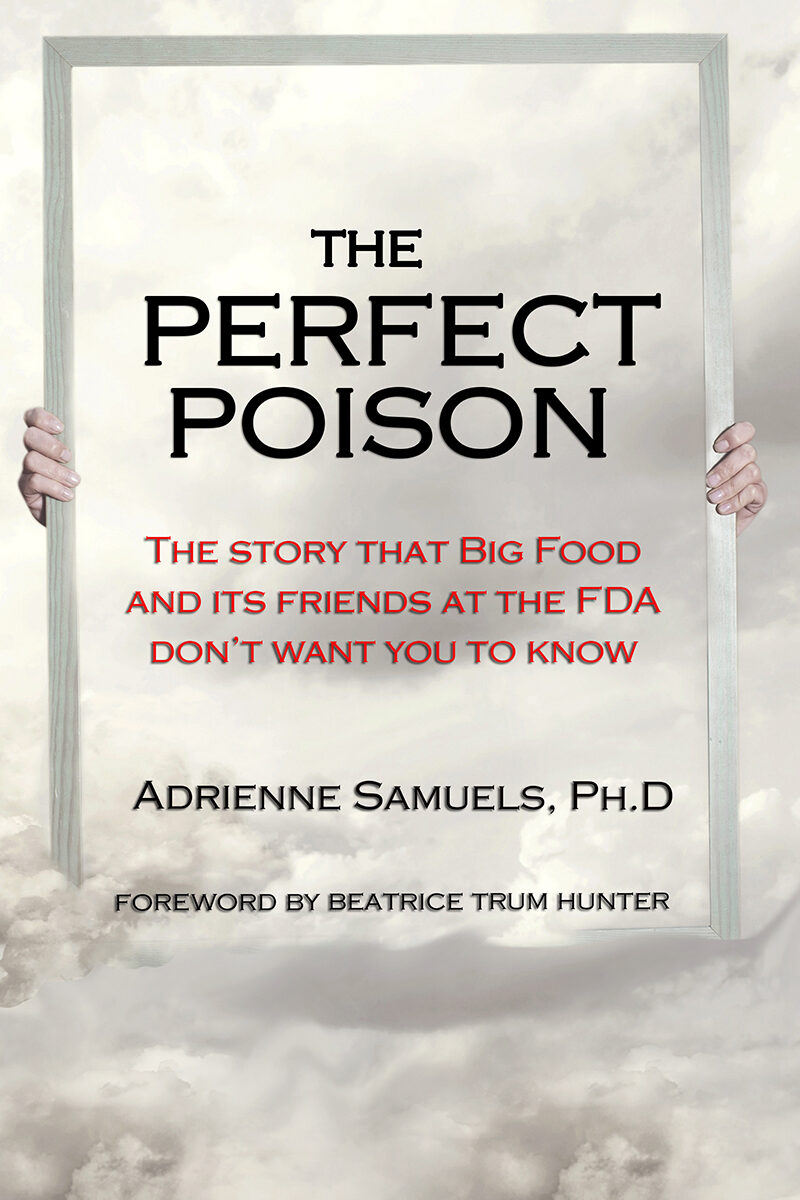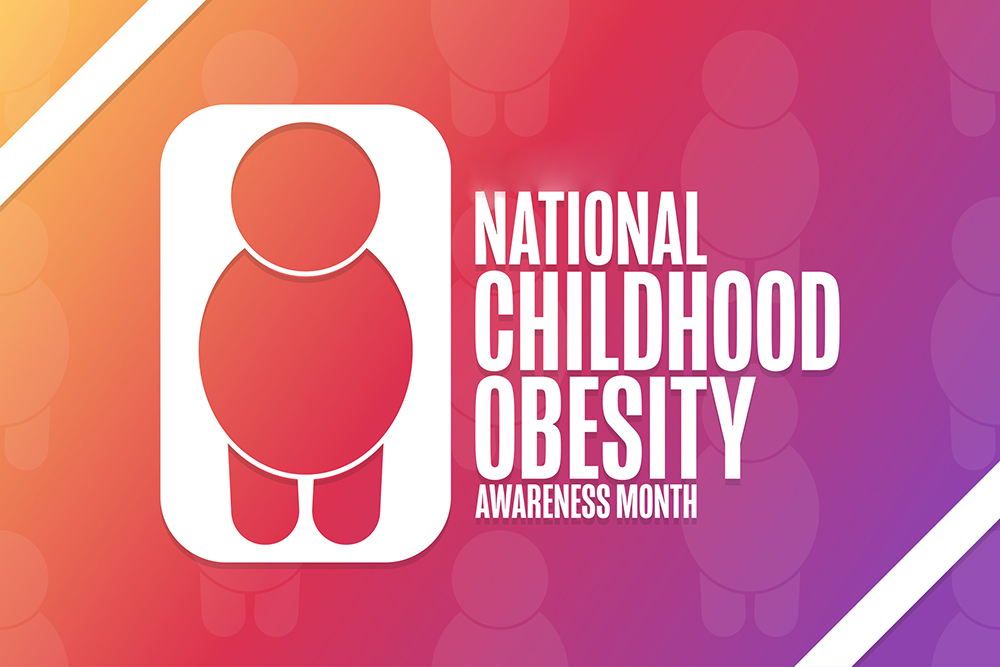Prevention is always a good idea, but especially when brain cells regulating appetite and satiety can be obliterated by excitotoxic free glutamate consumed by pregnant women. And for free-glutamate-induced obesity there is no cure.
A short explanation of the obesity epidemic
I know something you don’t know. I know that man-made free glutamic acid (free glutamate), the active ingredient in monosodium glutamate (MSG), caused and maintains the obesity epidemic.
Evidence? Some things are easy to understand.
1. Anyone who was reading medical journals in 1969 and the 1970s knew that monosodium glutamate (which contains manufactured free glutamate) fed in large amounts to newborn animals causes brain damage in a particular area of the hypothalamus — brain damage that is aways followed by gross obesity, infertility, behavior disorders and other abnormalities (1).
2. The obesity epidemic materialized in the 1960s. Prior to 1957, there were people who had problems with obesity, but not in numbers so significant that they couldn’t be explained (2,3).
3. In 1957 the major U.S. producer of MSG and the free glutamate contained in it started producing free glutamate in sufficient amounts to cause that free glutamate to be excitotoxic – brain damaging (4).
Studies done over the years leave no question that there are three requirements for glutamate-induced brain damage, and that humans can meet them all:
A vulnerable brain –
The vulnerable brain in humans is the immature brain of a fetus or newborn, never protected by a blood-brain barrier.
Sufficient free glutamate to cause the free glutamate to become excitotoxic –
Virtually unlimited amounts of free glutamate became available in 1957 when production of free glutamate for use in food changed from extraction of glutamate from protein to production of free glutamate by bacterial fermentation (4).
A way to deliver the toxin to the vulnerable brain –
You couldn’t feed glutamate-containing ingredients to a newborn with a fork or a spoon. But if a pregnant woman consumes enough glutamate during the course of a day (which she will do if she is eating processed and ultra-processed foods), she will pass that glutamate through the placenta to her fetus, damaging the fetuses’ vulnerable brain.
It’s the timing that tells the story of the obesity epidemic.
Prior to 1957, there was obesity, but not in such amounts that it would be called an epidemic. During that time, glutamate was produced using a slow and costly method.
After 1957, there was sufficient production of glutamate to cause it to be excitotoxic – brain damaging. And sales of products containing free glutamate, not just MSG, were vigorously promoted.
Increases in the incidence of obesity began to be noticed in the early 1970s, when the first glutamate-induced brain damaged fetuses reached maturity as obese adults.
NOTES
1. The first study to address the possibility that glutamate from outside the body (from eating for example) might cause brain damage followed by obesity and reproductive dysfunction was published in 1969. At the time, researchers were administering glutamate to laboratory animals subcutaneously using Accent brand MSG because it had been observed that MSG was as effective for inflicting brain damage as more expensive pharmaceutical grade L-glutamate (7).
In the decade that followed, research confirmed that glutamate given as monosodium glutamate administered or fed to neonatal animals causes hypothalamic damage, endocrine disruption, and behavior disorders when given to immature animals after either subcutaneous (8-29) or oral (15,21,22,24,30-34) doses.
15. Olney, J.W. Glutamate-induced neuronal necrosis in the infant mouse hypothalamus. J Neuropathol Exp Neurol 30: 75-90, 1971.
21. Burde, R.M., Schainker, B., and Kayes, J. Acute effect of oral and subcutaneous administration of monosodium glutamate on the arcuate nucleus of the hypothalamus in mice and rats. Nature(Lond) 233: 58-60, 1971.
22. Olney, J.W. Sharpe, L.G., Feigin, R.D. Glutamate-induced brain damage in infant primates. J Neuropathol Exp Neurol 31: 464-488, 1972.
24. Burde, R.M., Schainker, B., and Kayes, J. Monosodium glutamate: necrosis of hypothalamic neurons in infant rats and mice following either oral or subcutaneous administration. J Neuropathol Exp Neurol 31: 181, 1972.
30. Olney, J.W., Ho, O.L. Brain damage in infant mice following oral intake of glutamate, aspartate or cystine. Nature(Lond) 227: 609-611, 1970.
31. Lemkey-Johnston, N., and Reynolds, W.A. Incidence and extent of brain lesions in mice following ingestion of monosodium glutamate (MSG). Anat Rec 172: 354, 1972.
32. Takasaki, Y. Protective effect of mono- and disaccharides on glutamate-induced brain damage in mice. Toxicol Lett 4: 205-210, 1979.
33. Takasaki, Y. Protective effect of arginine, leucine, and preinjection of insulin on glutamate neurotoxicity in mice.Toxicol Lett 5: 39-44, 1980.
34. Lemkey-Johnston, N., and Reynolds, W.A. Nature and extent of brain lesions in mice related to ingestion of monosodium glutamate: a light and electron microscope study. J Neuropath Exp Neurol33: 74-97, 1974.
2. Monitoring Human Tissues for Toxic Substances (https://www.ncbi.nlm.nih.gov/books/NBK234172/)
3. Overweight and Obesity in the United States, 1960–2000 https://www.infoplease.com/math-science/health/fitness-nutrition/overweight-and-obesity-in-the-united-states-1960-2000
4. Sano C. History of glutamate production. Am J Clin Nutr. 2009 Sep;90(3):728S-732S. doi: 10.3945/ajcn.2009.27462F. Epub 2009 Jul 29. PMID: 19640955.
1957
The year that mass produced free glutamate was first consumed by pregnant women, causing brain damage followed by irreversible obesity in their fetuses.
The obesity crisis. How it started. Why it continues.
Have you ever wondered how the obesity crisis began and why it continues to grow?
The Perfect Poison tells it all. The Perfect Poison tells how free glutamic acid (an excitotoxic amino acid found in flavor-enhancers) is passed by pregnant women to their fetuses where it causes damage to the arcuate nucleus of the hypothalamus leaving the child with no way to control appetite or satiety.
The paperback and Kindle editions are available right here!
To Your Health,
Adrienne Samuels, Ph.D.
Director
Truth in Labeling Campaign
Chicago, Illinois USA
Truthlabeling@gmail.com
MSG is a whole lot more than a flavor enhancer
By Adrienne Samuels
This article was published in “Wise Traditions.” Summer 2022, Volume 23, Number 2, pages 25-30.
Albert Einstein once coined the phrase “combinatory play” to describe the process of taking unrelated elements and concepts and putting them together to generate new ideas. Einstein did not invent the concepts of energy, mass or speed of light for his famous equation. Rather, he combined these concepts in a novel way, which restructured the way he looked at the universe.
In similar fashion, I have drawn from several different bodies of knowledge about the glutamate molecule (also called glutamic acid) to make the case that ingestion by humans of manufactured free glutamate — including the flavor-enhancing food additive monosodium glutamate (MSG), the sodium salt of glutamic acid is at the root of the obesity epidemic. The glutamate-obesity link stems from the following well-established facts: free glutamate is prevalent in the diet due to its presence in most processed foods; given its dietary prevalence, pregnant and lactating women routinely expose fetuses and newborns to free glutamate via the placenta and breastmilk; and, under some circumstances, free glutamate induces brain damage affecting the part of the brain that controls food intake and metabolism.
Glutamate is the principal neurotransmitter in humans, carrying nerve impulses from glutamate stimuli to glutamate receptors throughout the body. However, it is also widely recognized as a “Jekyll and Hyde” amino acid.1,2 When present in protein or released from protein in a regulated fashion through routine digestion, glutamate is vital for normal body function. On the other hand, when present in greater quantity than a healthy human needs for normal body function, it becomes toxic. In that instance, as an “excitotoxic” neurotransmitter, it fires repeatedly, damaging targeted glutamate receptors and/or causing neuronal and non-neuronal death by overexciting the glutamate receptors until their host cells die.3
THE RISE OF FOOD EXCITOTOXINS
In the 1990s, the first edition of the book Excitotoxins: The Taste that Kills by Dr. Russell Blaylock drew the public’s attention to neurotoxic food additives, which by then had already been in use for decades. As that book put it, an excitotoxin “literally stimulates neurons to death, causing brain damage of varying degrees.”4
MSG is one of the most well-known excitotoxins. MSG’s ongoing heyday began in 1957, when food scientists shifted from a slow and costly method that called for extraction of free glutamate from a protein source, to bacterial fermentation as a “new and improved” method for the production of free glutamic acid for use in food. From that point forward, the virtually unlimited production of free glutamate was guaranteed.
Following the surge in MSG and free glutamate production, boosted by aggressive advertising, many companies recognized that profits could be increased if they produced their own flavor-enhancing additives. It wasn’t long before competing manufacturers were adding dozens more excitotoxic food additives to the American diet. Companies soon flooded the market with flavor enhancers and protein substitutes containing free glutamate-ingredients such as hydrolyzed pea protein, yeast extracts, maltodextrin and soy protein isolate, as well as MSG.5,6 A further toxic load was added to that list when the Food and Drug Administration (FDA) approved the excitotoxin aspartic acid, used beginning in 1974 in aspartame, Equal® and related products.
According to Dr. Blaylock, the amount of MSG added to the food supply has doubled every decade since the late 1940s.7
SETTING THE STAGE FOR NEUROTOXICITY
Although I knew a great deal about the toxic effects of MSG, it was only as people began reporting adverse reactions following ingestion of foods that did not contain MSG that I realized it was the free glutamate in the MSG — and in flavor enhancers other than MSG — that was causing what consumers were calling “MSG reactions.”
There is no question that free glutamate ingestion does cause adverse reactions. Some scientists claim that it elicits transient adverse reactions only in a small subset of people sensitive to the substance. Others maintain, however, that it causes adverse reactions on a broader scale, ranging from simple skin rash to migraine headache,8 heart irregularities, seizures and anaphylactic shock. Despite what is known about adverse reactions and the potential for brain damage, FDA imposes no limits on the amount of either MSG or free glutamate that a single food ingredient may contain.
Research shows that three conditions must be met in order to induce glutamate neurotoxicity. The first important factor is the integrity and health of the brain. Harm is most likely occur when the brain is vulnerable, meaning either immature — such as the fetal or neonate brain — or damaged. A fetus will be even more vulnerable to glutamate insult than a newborn.
Second, a sufficient quantity of free glutamate must be present to enable it to become excitotoxic. Since the 1957 change in the method of MSG production, so many products contain excitotoxic ingredients that it is easy for a consumer to ingest an excess during the course of a day.9-12
Today, there is sufficient excitotoxic free glutamate in processed foods, dietary supplements, snacks, protein powders, protein drinks, protein substitutes, baby formula, enteral care products and pharmaceuticals for a person to consume the quantity necessary for that free glutamate to become excitotoxic.
Third, the excess glutamate must be delivered to the vulnerable brain. In children and adults, delivery of free glutamate to a vulnerable brain can be achieved simply through the person consuming a sufficient quantity of free glutamate to cause it to be excitotoxic. In fetuses and neonates, delivery of excitotoxic free glutamate will be achieved when a pregnant or lactating female passes brain-damaging excess free glutamate through the placenta or in mothers’ milk. There is nothing to prevent ingested glutamate from entering immature brains.
DELIVERY VIA PLACENTA AND BREASTMILK
Pregnant women deliver nourishment (and not so nourishing material) to the fetus in the form of material ingested and passed through the placenta. Studies show that MSG can cross the placenta.13,14 In other words, when glutamate passes to the fetus, the placenta does not filter out the glutamate.13 Research also indicates that MSG can cross the blood-brain barrier (BBB) in an unregulated manner during development; the BBB is not fully developed in either the fetus or the newborn. The BBB is easily damaged not just by ingestion of MSG but also other factors such as fever, stroke, trauma to the head, seizures and the aging process.1,15
MSG can also pass through the five circumventricular organs, specialized structures located along the surface of the brain ventricles.16 The circumventricular organs lie outside the BBB and are leaky at best at any stage of life,17,18 meaning they are not impervious to glutamate-induced brain damage.
Similar to drugs and alcohol,19 free glutamate can be passed to infants through mothers’ milk. The glutamate in mothers’ milk will be excitotoxic if lactating mothers ingest excessive quantities of free glutamate — quantities sufficient to cause the free glutamate to become excitotoxic. Newborn humans may also receive free glutamate through infant formula, which routinely contains ingredients featuring free glutamic acid and free aspartic acid.20
THE RISE OF OBESITY
In 1969, Dr. John Olney demonstrated that the glutamic acid component of MSG, when administered in high doses to mice, caused brain damage in various parts of the brain, including the arcuate nucleus (AN) of the hypothalamus, one of the circumventricular organs.21 (Recall that the circumventricular organs are outside the blood-brain barrier.) Neurocircuitries in the AN control multiple physiological functions, including regulating food intake and glucose homeostasis, and “disruption of this fine-tuned control leads to an imbalance between energy intake and expenditure as well as deregulation of peripheral metabolism.”22 Given the AN’s critical metabolic role, it is not surprising that Olney’s study went on to find that the glutamate-induced brain lesions led to “marked obesity” when the mice reached adulthood, as well as stunted skeletal development and female sterility.
In the decade that followed, others replicated Olney’s work, confirming that free glutamate fed to infant animals causes brain lesions in the arcuate nucleus, followed by gross obesity.23 In the 1970s, scientists employed by the glutamate industry challenged Olney’s findings, conducting studies that ostensibly failed to replicate glutamate-induced brain damage. However, it soon became apparent that these studies were industry sponsored — designed to guarantee that no traces of glutamate-induced brain damage would be found.
Sometime around 2016, I began thinking about the unexplained obesity epidemic and reading about the adverse effects of ultra- processed foods. I realized that because these highly processed foods were made of cheap ingredients and chemicals, they would necessarily contain flavor enhancers to compensate for the lack of flavor — with all of those flavor enhancers containing excitotoxic free glutamate. I also knew that after the late 1950s, essentially unlimited amounts of free glutamate were at processed food manufacturers’ disposal.
Knowing that glutamate fed in large amounts to animals with immature brains causes brain damage followed by gross obesity, and knowing that the brains of fetuses and neonates are vulnerable to glutamate insult, I reasoned that if glutamate in large amounts could be “fed” to human fetuses and neonates, brain damage and obesity would follow. With the proliferation of processed and ultra-processed foods, there was little doubt in my mind that there is sufficient free glutamate in most pregnant women’s diet to provide the “excess” glutamate needed to cause the glutamate ingested to become excitotoxic (brain-damaging), particularly if more than one glutamate-containing ingredient is consumed during the course of a day. It also occurred to me that if a pregnant woman consumed free glutamate in excess of what she needed for normal body function, the excitotoxic excess would be passed not just to the fetus through the placenta but later to the infant while nursing.
In short, the onset of the modern obesity epidemic can be traced back to the introduction of excessive amounts of free glutamate made available to humans following the modernization of MSG manufacture in 1957. The obesity exhibited in some individuals as they reach maturity can be linked to the excitotoxic amino acids ingested by their mothers when pregnant and lactating.
Once one understands the fact that excitotoxins are readily available to most pregnant women and new mothers, it is easy to grasp how these toxins are transported to the fetus and newborn where they cause brain damage, which in turn causes obesity. Consequently, excitotoxic amino acids delivered to fetuses and neonates by pregnant and nursing women should be recognized as risk factors for obesity.
Acknowledgment of the fact that glutamate-induced brain damage in fetuses and neonates lies at the root of the obesity epidemic should put an end to the shame and blame that have long been associated with obesity and should facilitate appropriate counseling and medical interventions. It should also serve as a valid starting point for new groundbreaking research.
LOOKING THE OTHER WAY
In this article, I have accounted for all five pieces to the puzzle of the obesity epidemic:
- The concept of excitotoxicity, with free glutamate being the principal excitotoxin;
- The fact of glutamate-induced brain dam- age followed by obesity;
- The abundance of excitotoxic glutamate in processed and ultra-processed foods;
- The fact that pregnant females can pass excitotoxic glutamate to their fetuses; and
- The correlation between the time that virtually unlimited amounts of free glutamate became available in food and the beginning of the obesity epidemic.
Nonetheless, ever since the first suggestion that MSG might have toxic potential, those with a financial interest in promoting MSG as a cheap and valuable flavor enhancer have denied its toxicity, launching well-funded, well-articulated campaigns to promote their products. Industry responses also include rigging studies to come to the foregone conclusion that MSG is a harmless food additive, and securing the active cooperation of regulators as well as the help of medical professionals, many of whom appear to be more than happy to look the other way.24 These actions may explain why the role of MSG and manufactured free glutamate in the obesity epidemic continues to be overlooked.
In 1950, Americans consumed about one million pounds of MSG; today, that number is three hundred million pounds. Given that almost all processed food and fast food contains MSG (usually not labeled),6 the food industry certainly knows that the additive they use to make their food taste good is a major cause of the current obesity epidemic. The message to consumers is clear: to lose weight, it’s important to avoid all processed food, and certainly not add MSG to the foods you prepare at home.
Adrienne Samuels, PhD is an experimental psychologist by training and educational psychologist by degree. Her interest in MSG’s toxic effects can be traced to the day she realized that her husband Jack went into anaphylactic shock after eating a meal containing MSG. Over the course of thirty years, Adrienne has monitored the MSG-related activities of the FDA, testified before the FDA and its agents, co-founded the Truth in Labeling Campaign and website (truthinlabeling.org), met with members of Congress, initiated and served as a plaintiff in a lawsuit over FDA’s failure to identify the toxic free glutamate in processed foods, filed Citizen Petitions requesting that FDA revoke the “generally recognized as safe” (GRAS) status of MSG and L-glutamic acid for any use in human food, and written numerous papers and journal articles. Adrienne continues to broaden her understanding of the toxic effects of MSG and its excitotoxic free glutamate component, sharing her findings with regulators, health care professionals and consumers. She can be contacted at questionsaboutMSG AT gmail.com.
****
MSG PROPAGANDA
In August 2021, the Washington Post published a puff piece on MSG, claiming that we have nothing to fear from the artificial flavoring that adds umami “spark” to many dishes.25 The author, Aaron Hutcherson, marginalized headaches and allergic reactions as minor symptoms in a few hypersensitive people. Said Hutcherson: “In addition to soup and eggs, MSG can be added to salad dressings, bread, tomato sauce, meat, popcorn, ‘an absolutely filthy martini,’ you name it. MSG is a great way to add flavor to just about anything except sweets. It’s particularly great with vegetables, too.”
He made no mention of the real problem with MSG: weight gain. If you search “msg-induced obesity” at PubMed, you will come up with almost one hundred citations. Most of the citations are animal studies, not human trials. This is because it’s hard to get research animals to overeat and become obese — in order to study obesity — so scientists feed rats, mice and hamsters MSG to make them eat more and put on weight. The food industry has argued that the amount of MSG given to these animals is way more, as a function of body weight, than humans would ever eat. or, they say, the association with weight gain and MSG is really an association of weight gain and processed foods, since MSG is in almost all processed foods.
What happens when we consume small amounts of MSG as a flavoring day after day after day? A 2008 study published in the journal Obesity provides confirmation that MSG indeed causes weight gain in humans, and not because of its inclusion in processed foods.26 In this well-designed trial, researchers at the University of north Carolina at Chapel Hill studied seven hundred fifty Chinese men and women, ages 40 to 59, living in three rural Chinese villages. Most of the study subjects prepared their meals at home without commercial processed foods, and about 82 percent used MSG. Those participants who used the highest amounts of MSG had nearly three times the incidence of overweight as those who did not use MSG, even when the researchers accounted for physical activity and caloric intake.
What about the argument, made by the Food and Drug Administration (FDA) and quoted by Hutcherson in the Washington Post article, that “The glutamate in MSG is chemically indistinguishable from [the essential amino acid] glutamate present in food proteins”? This sentence is true, but the FDA’s and Hutcherson’s second assertion — that “our bodies ultimately metabolize both sources of glutamate in the same way” is false. The glutamic acid in foods like meat is attached to various peptides and other compounds that release it when required and prevent it from overstimulating the nervous and endocrine systems; the glutamic acid in MSG, in contrast, is “naked,” highly reactive and unmitigated by its milieu.
****
What’s in a name?
MSG has many different disguises. The table below lists ingredients that always contain MSG, often contain MSG or create MSG during processing.
| Always contains MSG | Often contains MSG — | or creates MSG |
| Autolyzed yeast | Anything enzyme-modified | Malt flavoring |
| Calcium caseinate | Anything protein-fortified | Maltodextrin |
| Geletin | Anything ultra-pasteurized | Natural flavors or flavorings |
| Glutamate | Barley malt | natural beef/chicken/pork flavoring |
| Glutamic acid | Bouillon | Pectin |
| Hydrolyzed vegetable protein | Broth | Powdered milk |
| Monopotassium glutamate | Carageenan | Protease |
| Sodium caseinate | Citric acid | Seasonings |
| Textured protein | Cornstarch | Soy protein |
| Whey protein | Enymes | Soy protein isolate |
| Yeast extract | Flavors or flavorings | Soy sauce |
| Yeast food | Malt extract | Stock |
| Whey protein |
REFERENCES
- Onaolapo AY, Onaolapo OJ. Dietary glutamate and the brain: In the footprints of a Jekyll and Hyde molecule. Neurotoxicology. 2020;80:93-104.
- Morley WA, Seneff S. Diminished brain resilience syndrome: A modern day neurological pathology of increased susceptibility to mild brain trauma, concussion, and downstream neurodegeneration. Surg Neurol Int. 2014;5:97.
- Excitotoxicity and cell damage. https://www.sciencedaily.com/terms/excitotoxicity.htm
- Blaylock RL. Excitotoxins: The Taste that Kills. Santa Fe, New Mexico: Health Press, 1994.
- Teller M. MSG: Three little letters that spell big fat trouble. Wise Traditions. Spring 2017;18(1):42-46.
- Morell SF. MSG and free glutamate: Lurking everywhere. https://nourishingtraditions.com/msg-free-glutamate-lurking-everywhere/
- Blaylock RL. Excitotoxins, neurodegeneration and neurodevelopment. Available at:
http://landofpuregold.com/the-pdfs/Excitotoxins.pdf. - Interview with Jodi Ledley. Weston A. Price Foundation, Aug. 10, 2018. https://www.
westonaprice.org/health-topics/interview-with-jodiledley/ - Global monosodium glutamate market poised to surge from USD 4,500.0 million in 2014 to USD 5,850.0 million by 2020. Market Research Store, Mar. 17, 2016. https:// www.globenewswire.com/news-release/2016/03/17/820804/0/en/Global-Monosodium- Glutamate-Market-Poised-to-Surge-from-USD-4-500-0-Million-in-2014-to-USD- 5-850-0-Million-by-2020-MarketResearchStore-Com.html
- Global flavor enhancers market. BCC Research, Dec. 2018. https://www.bccresearch. com/partners/verified-market-research/global-flavor-enhancers-market.html
- Global food flavor enhancer market by type (monosodium glutamate (MSG), hydrolyzed vegetable protein (HVP), yeast extract others), by application (restaurants, home cooking, food processing industry) and by region (North America, Latin America, Europe, Asia Pacific and Middle East & Africa), forecast to 2028. Dataintelo, n.d. https://dataintelo. com/report/food-flavor-enhancer-market
- Sano C. History of glutamate production. Am J Clin Nutr. 2009;90(3):728S-732S.
- Frieder B, Grimm V E. Prenatal monosodium glutamate (MSG) treatment given through the mother’s diet causes behavioral deficits in rat offspring. Int J Neurosci. 1984;23(2):117- 126.
- Yu T, Zhao Y, Shi W, et al. Effects of maternal oral administration of monosodium glutamate at a late stage of pregnancy on developing mouse fetal brain. Brain Res. 1997;747(2):195-206.
- Nemeroff CB, Crisley FD. Monosodium L-glutamate-induced convulsions: Temporary alteration in blood-brain barrier permeability to plasma proteins. Environ Physiol Biochem. 1975;5(6):389-395.
- Benarroch EE. Circumventricular organs: Receptive and homeostatic functions and
clinical implications. Neurology. 2011;77(12):1198-1204. - Price MT, Olney JW, Lowry OH, Buchsbaum S. Uptake of exogenous glutamate and
aspartate by circumventricular organs but not other regions of brain. J Neurochem. 1981;36(5):1774-1780. - Broadwell RD, Sofroniew MV. Serum proteins bypass the blood-brain fluid barriers for extracellular entry to the central nervous system. Exp Neurol. 1993;120(2):245-263.
- https://www.cdc.gov/breastfeeding/breastfeeding- special-circumstances/vaccinations-medications-drugs/ alcohol.html
- Samuels JL. MSG in infant formula. Weston A. Price Foundation, Dec. 31, 2001. https://www.westonaprice. org/health-topics/modern-foods/msg-in-infant-formula/
- Olney JW. Brain lesions, obesity, and other disturbances in mice treated with monosodium glutamate. Science. 1969;164(3880):719-721.
- Jais A, Brüning JC. Arcuate nucleus dependent regulation of metabolism pathways to obesity and diabetes mellitus. Endocr Rev. 2022;43(2):314-328.
- Burde RM, Schainker B, Kayes J. Monosodium glutamate: necrosis of hypothalamic neurons in infant rats and mice following either oral or subcutaneous administration. J Neuropathol Exp Neurol. 1972;31:181.
- Samuels A. The toxicity/safety of processed free glutamic acid (MSG): a study in suppression of information. Account Res. 1999;6(4):259-310.
- Hutcherson A. Why you shouldn’t fear MSG, an unfairly maligned and worthwhile seasoning. Washington Post, Aug. 27, 2021.
- He K, Zhao L, Daviglus ML, et al. Association of monosodium glutamate intake with overweight in Chinese adults: the INTERMAP study. Obesity (Silver Spring).
2008;16(8):1875-1880.
Released documents expose that Ajinomoto paid the U.S. Dept. of Agriculture over half a million dollars to do a study designed to prove that consuming MSG is good for you
Last December we revealed a remarkable finding, a 2010 press release issued by Ajinomoto telling about the company’s cozy partnership with the U.S. Department of Agriculture to study MSG.
At that time, we tracked down and sent some questions to the scientist named in the release, Dr. Kevin Laugero, who is still affiliated with the USDA/ARS (Agricultural Research Service). When we didn’t hear back from him, we took the next step, a Freedom of Information Act request with the USDA.
We recently received a response from the USDA. Here’s what we learned in a 53-page release of documents, many of them invoices from the USDA to Ajinomoto.
- Ajinomoto, possibly the world’s largest manufacturer of MSG, paid the USDA a total of $674,000 to conduct a three-year “study” on the “effects of ingesting MSG on energy balance and eating behavior.” The hypothesis proposed was that daily consumption of MSG will “reduce body weight rebound.”
- Ajinomoto, known as “the cooperator” in the official “statement of work” filled out by the USDA, was given a wire routing number to zip those funds into an account at Citibank.
- The original budget of $598,653 was increased twice to “expand subject recruitment efforts,” hire a staff recruiter, project manager and up the stipend paid to volunteers, which was originally $580 per person for a 25-week commitment.
Although Dr. Laugero finally did reply, he would only say that the Ajinomoto glutamate research project was completed and that scientists have analyzed the data, which have not been published. “I can’t really comment on the results.” he said.
But by far the most interesting part of the documents we received has to do with the “research plan,” a study to be produced by three USDA researchers – including Dr. Laugero. The outline describes a six-month scheme for psychological and metabolic evaluations, cognitive testing, multiple blood draws, saliva samples, “snack food buffets,” mental stress tests, and MRI brain scans that collected data on the subject’s “neural responses to food cues,” none of which appear to be relevant to energy balance and eating behavior. Volunteers were sent questionnaires, and for the MSG test group there would be consumption of MSG (supplied as a broth powder) prior to their breakfast, lunch and dinner – called the “intervention phase.”
But evidently something went wrong, as the study was never published. Since we know the Glutes never publish anything that might suggest that MSG is toxic, and since the USDA was not even pretending to do an independent study, apparently when the results didn’t come out as desired the report of the study vanished. If not for the twelve-year-old press release we found online that tipped us off, no one outside of the USDA would know about this “partnership” payout.
One might ask why this study was done in the first place? And why done by the USDA?
We think we may know at least part of the answer.
Two years before the USDA/Ajinomoto joint venture, a study from the University of North Carolina clearly linked MSG consumption in people to weight gain. According to epidemiologist Dr. Ka He, those who consume large amounts of MSG increase their risk of being overweight by a whopping 175 percent.
To counter that, Ajinomoto jumped in with a rodent study that was published in the journal Physiology & Behavior, concluding that rats who drank MSG spiked water were lean and healthy. But perhaps comparing their lab rats to humans didn’t seem as effective – at least publicity wise.
So, why not collect a group of human lab animals to study, and have the good name of the USDA associated with Ajinomoto and the safety of MSG? Ajinomoto found the USDA more than willing to play along.
As we said last year, this is a stunning example of how closely connected industry is with our so-called watchdog federal agencies.
Those interested in learning more about agency/industry cooperation will find interesting material at Industry’s FDA: https://www.truthinlabeling.org/assets/industrys_fda_final.pdf. Those with interest in methods used by the Glutes to come to the foregone conclusion that MSG is a harmless food additive can access How the “MSG is safe” game is played: https://www.truthinlabeling.org/safe.html
How glutamate caused (and continues to cause) the obesity epidemic
I wonder if it’s a conspiracy that’s behind keeping the truth about the obesity epidemic from the public, or if it’s just one immensely powerful person pulling the strings. There has always been propaganda by the boatload, even carried in distinguished publications such as the New York Times and Washington Post. Sometimes as an advertisement. Sometimes dressed up as news. But ever present.
From the time that neuroscientist Dr. John W. Olney discovered that free glutamic acid (a.k.a. glutamate) given to animals killed brain cells in the part of the brain responsible for controlling weight, one rich and powerful manufacturer of glutamate (also the manufacturer of monosodium glutamate – MSG), set out to convince the American public that MSG is a harmless food additive.
The campaign began by pretending to replicate Olney’s studies. That didn’t work out, because they were quickly exposed for what they were, and by 1980 researchers were using MSG to kill neurons and produce obesity in experimental animals to facilitate their research on a whole variety of abnormalities, all with ties to glutamate.
Then, as people began to realize that ingestion of MSG was followed by adverse reactions ranging from simple skin rash to asthma, migraine headache, tachycardia, atrial fibrillation, anaphylaxis and seizures, the Glutes turned to producing double-blind studies that failed to find more reactions to MSG than reactions to a placebo, claiming they now had what amounted to proof that MSG is harmless. But since the placebos all contained excitotoxic amino acids that cause reactions identical to the reactions caused by MSG, they only demonstrated that they were not above doing something that might qualify as scientific fraud.
Now the idea of conspiracy has come back to haunt me. You see, I’ve uncovered the fact that the root of the obesity epidemic lies in damage done to the vulnerable brains of unborn children. I studied the 1970s studies done by Olney and others, thinking that if obesity could be caused by feeding glutamate to infant animals, it could be caused by feeding glutamate to infant humans – or even more effectively to fetuses.
These are the facts:
Olney began with infant animals. Newborn humans and fetuses would be comparable.
Olney began with animals whose brains could be damaged by excitotoxic glutamate. Newborn humans and fetuses would be comparable.
Olney fed exceedingly large amount of glutamate to those animals. Since 1957, exceedingly large amounts of free glutamate have been available, accessible and consumed by humans.
In 1957:
1) the method for producing glutamate (found in MSG) was changed to facilitate virtually unlimited production of free glutamate and MSG, and
2) ultra-processed foods — all of which contain flavor-enhancing free glutamate in ingredients such as autolyzed yeast extract, sodium caseinate, maltodextrin, glutamic acid, and hydrolyzed proteins as well as MSG – became readily available, accessible, and increasingly more popular.
It is true that any one ingredient will contain a limited amount of free glutamate. But glutamate in amounts needed to produce brain damage in vulnerable humans is readily available to those who consume a number of processed and ultra-processed foods during the course of a day.
The glutamate delivered to Olney’s neonatal animals was delivered in food fed to them. The glutamate delivered to humans with vulnerable brains is delivered by their pregnant mothers.
Newborn humans could only receive glutamate in mothers’ milk or infant formula. But fetuses are “fed” through the umbilical cord, through the placenta. And if a pregnant woman ingested large quantities of free glutamate, as she might if her diet included processed and ultra-processed food, the excitotoxic free glutamate would cause damage to the brain of her fetus just as it caused damage to the brains of Olney’s animals. And in humans that brain damage would be followed by intractable obesity just as it was in Olney’s animals.
(And isn’t it interesting that the obesity epidemic has hit hardest in low- income areas — locations with limited access to real food, and a dependence on processed and ultra-processed food).
Journal after journal has refused to publish the information that I have just shared with you. The latest was Obesity, the prestigious journal of The Obesity Society. It is common knowledge among the well informed that medical journals are now controlled by Big Pharma. But that hardly qualifies as a “conspiracy.” It’s just the way things are in the world of power and greed.
But when access to my account in LinkedIn disappeared along with all mention of the Safe Food group that I had established, the word “conspiracy” appeared brightly before me and will not go away.
Also finding its way into my consciousness are the assurances that 1) my description of how the obesity epidemic happened is accurate, and 2) that the Glutes have no way to defend against the truth that manufactured free glutamate consumed by pregnant women lies at the root of the obesity epidemic – except to bury that truth – which their assault on my LinkedIn account demonstrates.
Adrienne Samuels
An open letter to Dr. Anthony G. Comuzzie

This February 28, 2022 letter to Dr. Anthony G. Comuzzie, CEO of the Obesity Society (which publishes the journal Obesity), requesting that he suggest a vehicle for making information about brain damage caused by free glutamate ingested by pregnant women and passed to their fetuses and neonates available to researchers and healthcare practitioners, has not been answered or even acknowledged.
A copy of the letter is being posted here as an open letter to Dr. Comuzzie, with the hope that someone may forward it to him, and that he will respond.
Anthony G. Comuzzie, PhD, FTOS
contact@obesity.org
Dear Dr. Comuzzie,
Are you aware that the editors of Obesity have refused to publish studies that demonstrate that the obesity epidemic was set in motion, and is sustained, by brain damage caused by pregnant women passing excitotoxic free glutamate to their offspring?
Both 1) an overview of the subject submitted as a Perspective, and 2) a Review, demonstrating the role that ingestion of free glutamate ingested by pregnant women plays in the production of intractable obesity have been offered to your journal Obesity, and been refused consideration.
I find that very strange. How can papers that suggest and document the fact that a common amino acid used in processed food is responsible for the obesity epidemic not be assigned sufficient priority to allow publication in Obesity?
It is obvious from texts of rejection letters that the editors of Obesity have no interest in resolving the cause of the obesity epidemic, suggesting new lines of investigation, and providing those who are afflicted with obesity appropriate psychological and medical interventions.
The first manuscript was submitted as a perspective, a category that limits submissions to 1000 words and 10 references. As specified by the journal’s instructions, “Perspectives can provide new ideas on an old problem or commentary/opinion of a hot topic.” Accordingly, the manuscript provided a new idea on an old problem within the limited (10) references allowed, although there are many more references available to support its thesis. Appropriately, given that this was submitted as a perspective, taking seemingly unrelated things and putting them together to generate a new idea as Einstein was in the habit of doing, there was no hypothesis testing or experimental design for new data demonstrating suitable controls, and there were no statistical tests reported.
In rejecting it, editor Eric Ravussin stated that “there was really nothing novel on the specific role of glutamate as a trigger of obesity in your piece. All the scientific references but one were from more than 20 years ago.”
I find it hard to comprehend how it could be that the idea of glutamate ingested by pregnant women causing brain damage in fetuses and neonates followed by intractable obesity is not novel. To suggest that data have a shelf life of 20 years would put Einstein and Galileo out of business.
The second submission was a request to submit a review to Obesity. It was rejected in part because it was submitted by a single author, and in part because there was “no systematic evaluation of clinical trials or meta-analysis to evaluate glutamate on obesity risk,” neither of which would necessarily be appropriate for a review. Moreover, it was rejected because “we also request reviews on hot topics in the field of obesity.” I can’t think of any hotter topic in the field of obesity than the cause of the obesity epidemic.
Given that the journal of the Obesity Society will not publish information on the cause of the obesity epidemic, sharing insights that will benefit those who suffer intractable weight gain, would you, please, suggest a vehicle for making information about brain damage caused by free glutamate ingested by pregnant women and passed to their fetuses and neonates available to researchers and healthcare practitioners?
I look forward to your response.
Sincerely,
Adrienne Samuels, Ph.D.
Director
Truth in Labeling Campaign
Chicago, Illinois USA
Questions and answers: What’s causing the obesity epidemic?
What’s causing the obesity epidemic?
They’re called excitotoxins.
These are Jekyll and Hyde amino acids.
On the one hand, they’re absolutely necessary for human
health.
On the other hand, they turn toxic/poisonous when more are
eaten than needed.
What damage do they do?
They damage the brains of vulnerable people.
People who have had head injuries,
People whose brains are not yet mature,
A newborn child,
A child in the womb: a fetus.
How can excitotoxins get to the immature brains of newborns and
fetuses?
Excitotoxins are eaten by pregnant women.
Pregnant women pass what they eat to their unborn offspring
(fetuses) through the umbilical cord and the placenta.
Nursing mothers pass what they eat to their babies through mother’s
milk.
Exactly what damage do these excitotoxins do to the brains of fetuses and newborns that brings about obesity?
They obliterate (wipe out) the neurons (nerve cells) in that part of the
arcuate nucleus of the hypothalamus that would have played a role in
weight control, had they not been destroyed.
And although the empty space left in the brain when the neurons are
destroyed is filled in with other cells, the neurons are not replaced.
What excitotoxins do this?
The one known best from research done in the 1970s is glutamic acid
(a.k.a. glutamate).
Glutamate is essential for normal body function. There has always
been glutamate in food. Why haven’t more people always been
obese?
Until 1957, the glutamate in food (and there is glutamate in
essentially all food) was almost always part of something larger than
itself. It was a part of protein. Scientists who wanted to examine
glutamate had to break the protein apart before they could examine it.
(They speak of glutamate being “bound up” in protein: tied to other
amino acids in long chains. That’s still true.)
Glutamate bound in protein is not excitotoxic. Only glutamate outside
of protein causes brain damage.
In 1957, the U.S. manufacturer of excitotoxic glutamate (for use in
monosodium glutamate) revised its manufacturing process, and from
that point on, virtually unlimited amounts of excitotoxic manufactured
free glutamate (MfG) were produced. After 1957, there was sufficient
MfG in ultra-processed food (at least in the U.S.) to provide the
“excess” amounts of MfG needed to cause brain damage.
Then why didn’t the “obesity epidemic” happen in 1957?
1957 was the year that the new and improved method for fabricating
virtually unlimited amounts of the excitotoxic – brain damaging – MfG
was put into production. But 1960 was the year that increased
obesity began to be noticed. 1960-62 saw the first statistics kept on
numbers of overweight people.
The secret behind the obesity epidemic
Pregnant people shouldn’t be eating processed food. Because its toxic chemicals will cause intractable/unrelenting obesity in their offspring.










